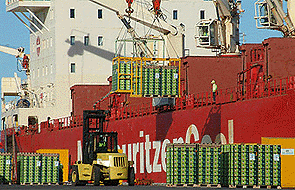
By Anne Boniface*
 While it is often the dairy sector which dominates the headlines in the New Zealand agriculture scene, it is by no means the only sector which has enjoyed favourable conditions of late.
While it is often the dairy sector which dominates the headlines in the New Zealand agriculture scene, it is by no means the only sector which has enjoyed favourable conditions of late.
One of the quiet achievers recently has been the horticulture industry.
New Zealand’s two highest value horticulture exports (excluding wine) are apples and kiwifruit.
Over the year to April 2014, kiwifruit exports were valued at almost $900 million while apple exports were valued at $540 million (total NZ goods exports were around $49 bln).
Geographically, the apple industry is centred on the Hawke’s Bay and Nelson, while the kiwifruit industry is concentrated in the Bay of Plenty.
Although New Zealand is one of the larger kiwifruit producers globally (along with China, Italy and Chile) it plays a much smaller role in international apple markets.
In both industries, many growers have enjoyed favourable climactic conditions for the most recent season. Good climactic conditions will come as a bonus to those in the kiwifruit industry who have faced huge challenges in recent years.
Psa, a bacteriam that can result in the death of kiwifruit vines, was discovered in NZ for the first time in late 2010. The virus is now widespread throughout New Zealand, with more than three quarters of NZ orchards known to have the bacterium present, and has had a big impact on production volumes, hitting production of gold kiwifruit particularly hard.
According to Zespri (the sole marketer of kiwifruit outside Australasia), its export volumes fell 16% in 2012/13 season from the year before, and were down a further 15% in the 2013/14 season.
However it looks as if the industry is fast approaching a turning point.
The industry’s response to Psa, led by Kiwifruit Vine Health Inc (KVH), a pan-industry organisation established in December 2010, has had a considerable amount of success. A Psa-tolerent gold variety has been developed by the industry, and growers have been making good progress introducing this new variety.
Going forward, export volumes are expected to recover as fruit from these new Gold3 vines are harvested.
By 2018, 50 million trays of the new variety are expected to be produced annually. These developments, in conjunction with good prices on international markets, favourable growing conditions and solid international demand have boosted optimism in the sector.
Looking ahead, as NZ production of gold kiwifruit improves, we are likely to see some downward pressure on prices. However, the industry, like many other NZ commodity food exporters, should benefit from the growing integration with Asia.
In recognition of this, Zespri has expressed an intention to continue investing in developing markets in China, South East Asia and the Middle East.
For similar reasons, prospects for the apple industry are also encouraging.
As in the kiwifruit industry, innovation and the introduction of new varieties has played an important role in the improving fortunes of the apple industry.
While Braeburn and Royal Gala still dominate NZ export volumes, a wide range of new varieties, often replacing Braeburn, have been developed in recent years in response to customer demands.
The importance of export markets in Asia and the Middle East is likely to continue to grow.

--------------------------------------
Anne Boniface is a senior economist at Westpac. This article was first released in Westpac's Fortnightly Agri Update here




We welcome your comments below. If you are not already registered, please register to comment.
Remember we welcome robust, respectful and insightful debate. We don't welcome abusive or defamatory comments and will de-register those repeatedly making such comments. Our current comment policy is here.